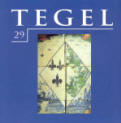 bevat artikelen over de volgende onderwerpen:
bevat artikelen over de volgende onderwerpen:
Een wapenschild op majolicategels - een les in heraldiek
Frans Caignie - page 4
The lozenge shield in the majolica floor of the chapel of Rameyen Castle at Gestel (Belgium) includes three features that call for closer study: the charges, consisting of lilies and lions, and the lozenge shape of the shield. Their analysis constitutes a lesson in heraldry.
The three Brabant statant fleur-de-lis are placed two and one, two in the chief and one in the base. These are the charges of Jan van Immerseele (†1527), margrave of Antwerp from 1504 to 1520. The three lions rampant vert (green) are crowned or (gold), armed and langued gules (red). These are the arms of Maria de Lannoy (†1549), spouse of Jan van Immerseele. The engrailed border and the star on the right-hand half of the shield are differences denoting a side-branch of the family tree. The lozenge shield is divided vertically into two halves. This impaling denotes the married state, the husband's arms being placed to the dexter (right) and the wife's to the sinister (left). Left and right are from the point of view of the shield bearer on the battle field. Experts consider the lozenge shield a heraldic aberration since it allows insufficient room for depicting the charges - as the near-toppling lions here amply demonstrate.
It is fascinating to check how the design of a coat of arms in majolica tiles conforms to the rules of heraldry and genealogy and to find the reason for minor deviations.
Haardachterwandtableaus uit de eerste helft van de zeventiende eeuw - Deel II
dr. J. Herbert van den Berge - page 8
Part 1 of this article in Tegel 28 was concerned with general aspects of tile pictures on rear walls of fireplaces. They were divided into five categories. Part 2 focuses on some specific features of these tile pictures: their emergence in the first quarter of the 17th century and almost total disappearance towards the end of the second quarter; the way in which the backs of the tiles are numbered in ascending order and exceptions; proof of the use of sponsen; the band of text on the lowest horizontal tile row. The third and concluding part of this article will deal with: the standard height and width of the pictures and exceptions, and the various centres of production.
Nederlandse tegels op enkele zeventiende eeuwse Delftse schilderijen
Margot Allingham - page 21
Can we rely on paintings to show us how other people lived? Can we trust the tiles shown in paintings to be true representations of tiles used in homes of that period? Dutch tiles in selected 17th century Delft paintings are listed and described in order to answer that question.
De Nederlandse invloed op Duitse tegels
Andreas Heger - page 27
In Germany it was only in the latter half of the 17th century that tiles were produced. The influence of the Netherlands was very strong not only on the corner motifs and borders but also on the designs. Dutch tiles were widely known in Germany, where they were often used in ordinary homes and farmhouses as well as in manorhouses and castles. In trade and culture, Germany was at that time strongly orientated towards its neighbour the Netherlands. It was difficult for the German tile industry to compete with the Dutch factories. The latter, which specialised in tile production, had at their disposal an extensive network of distributors and an excellent transport system. For the German potteries tile production was only a sideline. Initially their lack of experience resulted in technical shortcomings. On the other hand, as German factories did not always work from sponsen, the individual painters had to a large extent to rely on their own creativity.
'De Tegelschilders' van A.G.A. Ridder van Rappard
F.H. Landzaat - page 30
A picture entitled ’The Tile Painters' has been on loan to the Dutch Tile Museum (Otterlo) for a few years. It was painted by Anthon Ridder van Rappard in Utrecht in 1884 and shows tile painters at work in the painters studio of `De Nijverheid' tile factory. Between 1880 and 1886 the artist was friends with Vincent van Gogh. They kept up a correspondence in which they candidly discussed each other's work. Van Gogh follows the progress of `The Tile Painters' with interest, but when Van Rappard vents his criticism of the series of paintings on the theme of `The Potato Eaters' Van Gogh breaks off their friendship.
In the painting Van Rappard may have used the figure of `De Oude Tulk' (Old Tulk), a picture of whom appeared in the magazine Eigen Haard in 1878, for one of the busy workers.
Jubileumtableau van de 'Leidsche Broodfabriek'
Johan A. Kamermans - page 33
From February 2001 a tile picture showing the Leidse Broodfabriek (Leiden Bread Factory) has been on loan to the Dutch Tile Museum (Otterlo). This picture was made by De Porceleyne Fles in Delft, signed by the art director Leon Senf and bears the year letter for 1905. The commission document preserved in the archives and the correspondence provide information about the manufacture of the picture. It commemorates the 40th anniversary of the Bakery in 1906, or, more likely, the 40th anniversary of the appointment of the director.
'Het Tegelhuis' in Alphen a/d Rijn (1915-1983)
Jan Pluis - page 37
Het Tegelhuis (The House of Tiles) was established at Alphen aan de Rijn (province of South Holland) in 1915. Awareness of and demand for tiles had soared as a result of the huge expansion in building activity, the use of tiles in architectural design and the promotion of hygiene. Het Tegelhuis became a major supplier, and in 1920 the founder Dirk ten Cate Brouwer bought a factory, set up around 1906, at Bendorf near Koblenz (Germany). Here, up to the outbreak of World War II, vast quantities of biscuit tiles (blanks) were produced, which were then decorated and glazed at Alphen aan de Rijn. The designs were hardly innovative, which indicates that Dutch taste prior to World War II remained very traditional. Tiles with an Art Deco border in the style of the Amsterdam School (of architecture) are an exception. Tiles and tile pictures of this type are still to be found, particularly in butcher's and grocer's shops and schools.
After World War II blanks were no longer supplied from Bendorf (the firm had been sold in 1941) but by companies such as Sphinx and Mosa in Maastricht, Hemiksem near Antwerp or Westraven in Utrecht.
After the death of the founder Ten Cate Brouwer in 1962 Het Tegelhuis continued as a commercial enterprise until 1983, when it finally closed down.
Bibliography 2000-2001
page 46





